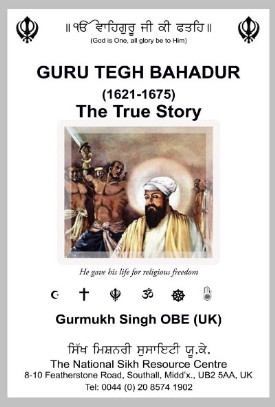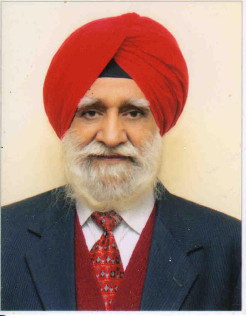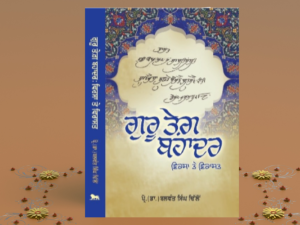Book Title: Guru Tegh Bahadur (1621-1675): The True Story
Author: Gurmukh Singh OBE, UK
Publisher: Sikh Missionary Society, UK;
Pages: xi +85;
Reviewer: Hardev Singh Virk, Mohali, India
I was fascinated to read this book online published by the Sikh Missionary Society of UK. The inner cover page declares unequivocally the theme of the book: "The account which follows is that of Guru Tegh Bahadur, Nanak IX. His martyrdom was a momentous and unique event. Never in the annals of human history had the leader of one religion given his life for the religious freedom of others".
The message of General Secretary of Missionary Society, Teja Singh Mangat, reveals that there is a sister volume of this book "Defender of Religious Freedom: Guru Tegh Bahadur" meant for students. He goes on to elaborate the purpose of this book: "Earlier publications have been influenced either by Brahmanical thought or are biased against Guru ji’s life mission and the noble cause which he pursued to the end. At least one text book published by the National Council of Educational Research and Training (NCERT) of India, relies on highly biased and even hostile non-Sikh evidence like the Mughal reports and Persian sources".
In the Introduction to this volume, the author reveals the purpose of writing this book: "The main reason for this publication is that earlier publications about the life and martyrdom of Guru Tegh Bahadur either do scant justice to the Guru’s active life or have been written more like fiction in the traditional saakhi (story-telling) style. One example is an otherwise informative biography of Guru Tegh Bahadur by Dr Trilochan Singh which is written more like a historical novel".
The book opens with a Chart of Sikh Gurus' succession followed by a Synopsis of the book, as in a Ph.D. thesis, and historical background of the Sikh movement. The book has been divided into four Sections: Life before Guruship; Guruship; Martyrdom; and After Martyrdom. The author has avoided superfluous details and summed up the whole thesis in just 56 pages of text. He has tried to remove the cobwebs created by other authors by his research oriented approach of sifting the facts from fiction.
Guru Tegh Bahadur was trained as a warrior by his father and he participated in most of the battles fought by Guru Hargobind. The author sums up his mission and life in Baba Bakala as follows: “Tegh Bahadur was now remote from the main seat of Sikhism, yet he carried with him the ambience in which he had grown. He was the example of virtues the Gurus had taught. He had humility and compassion and a firmness of mind. He lived a strict and holy life and spent most his time in meditation. Yet he was no recluse. He attended to family responsibilities. He went out riding and followed the chase. In the Sikh faith the temporal and the spiritual were not disjointed. This was amply attested in Guru Tegh Bahadur’s life.”
Tegh Bahadur was deputed by Guru Har Rai to preach Sikhi of Guru Nanak in remote areas: "Early in 1656, when Tegh Bahadur was visiting Kiratpur, he had a discourse with Guru Har Rai during which the Guru delegated the responsibility for the propagation of Sikhi in Malwa, Haryana and north-eastern parts of the Indian subcontinent to Tegh Bahadur". The author relies on the evidence of Bhatt Vahis to construct his thesis on the life of Guru Tegh Bahadur and his mission. Finally, the mantle of Guruship falls on the shoulders of Tegh Bahadur after the demise of Guru Harkishan in Delhi.
Part II on Guruship starts with a sub-heading "Confusion about Guruship". The author has tried his level best to bring out the truth of Guru Harkishan's prediction, 'Baba Bakale'. It is well known that this declaration, without naming the claimant of Gurgaddi, caused a lot of confusion and uncertainty among the Sikh Sangat about the ninth Guru. When Makhan Shah Lubana reached Baba Bakala to offer his bheta (offerings) to the Ninth Guru, he was confronted with 22 claimants, including Dhir Mall who had a large following in the area due to his lineage and proximity to the Guru family. His masand Shihan fired at the Guru on the bidding of Dhir Mall. Author has highlighted the role of Makhan Shah Lubana in this whole episode, who stayed for six months in the company of the Guru.
After Guru Nanak, it was Guru Tegh Bahadur who undertook extensive preaching tours of India. Along with his prominent Sikhs, Guru Jee covered Majha, Doaba and Malwa regions of Punjab and some areas of present day Haryana, known as Bangar. He undertook a long tour of North-Eastern India (1965-70) and preached Sikhi in far-flung areas of present day Bangla Desh and Assam state. The author has given the details of Guru Jee's house arrest in Delhi and the role of Raja Ram Singh to set him at liberty for his preaching tours. Another well wisher, Nawab Saif Khan of Saifabad (present day Bahadurgarh, near Patiala), was instrumental in getting the orders of house arrest rescinded by the emperor Aurangzeb.
The account of Guru Tegh Bahadur's family in Patna and their journey to Punjab is vividly described by the author in this section: "Meanwhile, the family group which had started from Patna sometime after the Guru left, reached Lakhnaur by 13 September, 1670, after stops at Ayudhia, Lakhnow, Nanakmata, Hardwar, Pehova (in Haryana) and Kurukshetra. From Delhi, the Guru and his Sikhs reached Lakhnaur after stopping at Rohtak, Kurukashetra, Pehova and other Sikh centres. Saif Khan accompanied the Guru to ensure his safety".
Part III covers the Martyrdom of Guru. The author sums up the mission of Emperor Aurungzeb as follows: "Aurungzeb’s brutality and fanaticism had no bounds and increased as he faced more revolts in the country. In desperation, he looked for the ultimate solution in an extreme form of Islam. His tormented soul sought refuge in religious fervour and in a vision of one-religion Islamic state. He especially targeted the Kashmiri Brahmins for conversion to Islam with the willing support of Iftikhar Khan, his bigoted governor of Kashmir from 1671 to 1675. The logic was to convert the upper class Brahmins who were at the apex of the Hindu caste system, so that others would follow ".
A delegation of Kashmiri Pundits led by Kirpa Ram Datt reached Anandpur and pleaded with Guru Tegh Bahadur to save them from the extreme cruelty of Aurangzeb to convert them to Islam. It was for the first time in the history of religions that the Guru was going to fight a battle on behalf of those of a belief system which he himself did not subscribe to, a belief system the basics of which Guru Nanak had rejected. The Guru was persuaded by his young son Gobind Das to confront Aurungzeb for the religious freedom of Hindus.
Guru Tegh Bahadur was arrested, on orders of Aurungzeb, at village Mallikpur Rangran on 12 July 1675 with his three companions, Dewan Mati Das, Sati Das and Dyal Das. They were persuaded to convert to Islam during their four month imprisonment at Sirhind. When they refused to accept this proposal, they were taken to Delhi in iron cages and produced before Aurungzeb who failed to persuade the Guru to convert to Islam. According to Guru Kian Sakhian, three choices were put to the Guru by the Emperor through the Royal Qazi. "These choices were: 1. Perform a miracle to show his divinity, 2. Accept Islam, and 3. Be prepared to die. Unhesitatingly, the Guru replied that if those were the only choices before him, then he willingly accepted the third choice".
Guru's companions were tortured and killed before his eyes. Guru Tegh Bahadur was martyred on 11 November, 1675. He was beheaded in full public view in Chandni Chowk Kotwali. According to the author: "The impact of this unique martyrdom was profound. It changed the course of the history of the Indian sub-continent, while it became the most prominent landmark in the landscape of martyrdoms for human rights and just causes in human history".
Part IV "After Martyrdom" is devoted to the events that happened after the martyrdom of the Guru in Delhi. Since this execution was publicised in North India, as a consequence, many devotees of Guru Nanak and followers of other faiths reached Delhi: "There was much at stake for the Brahmins of India. The event attracted a large audience. People would have travelled long distances to be at Delhi on that day. The great disturbance which followed has been compared to a sudden dark storm of suffocating dust (jhakhar)".
The daring Sikhs of Delhi had planned beforehand to secure the body and severed head of the Guru. The head was taken to Kiratpur by Bhai Jaita where it was received by young Guru Gobind Rai and his family. The body was lifted by Bhai Lakhi Shah Vanjara and his sons along with other Sikhs to be cremated secretly at Raisina village on 12 November 1675. The site where Guru Jee's body was cremated stands today Gurdwara Rakab Ganj, near Parliament house. Guru Tegh Bahadur’s sis (head) was cremated at Anandpur Sahib on 17 November, 1675.
The author has summed up the teachings of Guru Tegh Bahadur as follows: "We need to understand the Guru’s contribution to Sikh thought in the context of the same consistent Message of One Nanak Jote in all Guru-persons. They had already established the institutions which served the spiritual and organisational needs of the community. These educational institutions of sangat- pangat (congregation and community kitchen called langar) were not exclusive to the Sikhs but inclusive for all who sat at the same level without any form of distinction. They taught the egalitarian values of non-discrimination, community service, sharing and participation as preconditions for human salvation".
There is an annexure of 13 pages added at the end of this book which illustrates the social activism of the author. He has challenged the inclusion of a passage from Medieval India in the history book for class XI approved by the National Council for Educational Research and Training (NCERT) of India. The concluding paragraph from his Affidavit for consideration by the Honourable High Court of India reads as follows: "I am aggrieved by this offending passage from Medieval India. This passage belittles the great sacrifices of the Sikh Gurus and other Sikh martyrs; sacrifices, which turned the tide of Indian history and set India on the road to freedom. It is calculated to do maximum damage to Sikh history and heritage; it strikes at the root of Sikh faith; it is calculated to affect the psyche of the young reader in a way which can only be deleterious for the Sikhs. I am of the firm opinion that it offends the Sikh community world-wide".
The salient features of this book are its precision, logical interpretation of resources available and research done by the author to bring out the truth. The story of Guru Tegh Bahadur reads like a novel as the author has presented the facts in a fascinating style. My only suggestion is for better editing of the book. It will be most appropriate to bring out this volume in an enlarged edition of this book, including the Bani of Guru Tegh Bahadur in SGGS, during 400th birth anniversary celebrations in 2021.
~~~~~~~~~~~~~~~~~~~~~~~~~~~
Editor's note: You can read this book for free online here.









